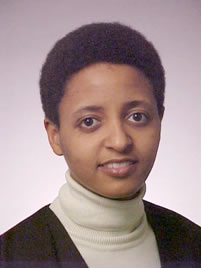Fuels from sunlight, water and carbon dioxide: A thermochemical approach
Professor Sossina M. Haile
California Institute of Technology
时间:3月29号(星期五) 上午9:30 (am)
地点:4号楼14楼第一会议室

Abstract
Perhaps the greatest challenge facing our planet is sustainable energy. Remarkably, more energy from sunlight strikes the earth in one hour than all of the energy consumed on the planet in one year. Thus, the real challenge is not one of identifying a sustainable energy source, but rather one of capitalizing on the vast, yet intermittent, solar resource base already at our disposal. Laboratories around the world are pursuing a variety of promising storage methods for converting solar energy into a reliable energy source for on-demand utilization. We have developed a unique thermochemical approach for converting water and carbon dioxide into storable fuels using the heat of the sun. Specifically, upon exposure to high temperatures, the extremely refractory oxide ceria, undergoes reduction without change in crystalline phase to release oxygen. On cooling in the presence of H2O (or CO2), the oxide is reoxidized, releasing H2 (or CO). The high catalytic activity of ceria at the cycling temperatures results in rapid fuel production and the favorable thermodynamics suggest high efficiencies may ultimately be possible. In addition to benchtop demonstrations of the approach, the results of a first set of ‘on-sun’ experiments are reported.
Biography
Sossina Haile received her B.S and Ph.D (1992) from the Massachusetts Institute of Technology, and M.S. from the University of California, Berkeley. Before joining the Caltech faculty in 1996, Haile spent three years as an assistant professor at the University of Washington, Seattle. Haile has received the NSF National Young Investigator Award (1994-99), Humboldt Fellowship (1992-93), Fulbright Fellowship (1991-92), and AT&T Cooperative Research Fellowship (1986-92). The Humboldt and Fulbright fellowships supported her research at the Max Planck Institut für Festkörperforschung [Institute for Solid State Research], Stuttgart, Germany (1991-1993). She is the recipient of the 2001 J.B. Wagner Award of the High Temperature Materials Division of the Electrochemical Society, the 2000 Coble Award from the American Ceramics Society and the 1997 TMS Robert Lansing Hardy Award.
Sossina Haile's research centers on ionic conduction in solids, with the twin objectives of understanding the mechanisms that govern ion transport, and applying such an understanding to the development of advanced solid electrolytes and novel solid-state electrochemical devices. Technological applications of fast ion conductors include batteries, sensors, ion pumps and fuel cells. It is to this last area that Dr. Haile's work is most closely tied. Materials under investigation in Dr. Haile's group include proton-conducting solid acid compounds, proton-conducting perovskites, mixed oxygen- and electron-conducting perovskites, and oxygen-conducting oxides.
Selected Publications
Fuel Cell Reviews and Commentaries
C. R. I Chisholm, D. A Boysen, A. B. Papandrew, S. Zecevic, S. Cha, K. Sasaki, A. Varga, K. P. Giapis and S. M. Haile, “From Laboratory Breakthrough to Technological Realization: The Development Path for Solid Acid Fuel Cells,” Interface Magazine, 18, 53-59 (2009).
S. M. Haile, Nature Journal Club - Commentary on advanced anodes for solid oxide fuel cells, Nature 443, 375 (2006).
Thermochemical Approaches to Solar Fuels
W.C. Chueh, C. Falter, M. Abbott, D. Scipio, P. Furler, S. M. Haile and A. Steinfeld, “High-Flux Solar-Driven Thermochemical Dissociation of H2O and CO2 Using Nonstoichiometric Ceria,” Science, 330, 1797-1801 (2010).
W. C. Chueh and S. M. Haile, “A Thermochemical Study of Ceria: Exploiting and Old Materials for New Modes of Energy Conversion and CO2 Mitigation,” Phil. Trans. Roy. Soc. 368, 3269-3294 (2010).
Fuel Cells and Electrocatalysis (Solid Acid Electrolytes)
M. W. Louie, A. Hightower and S. M. Haile, “Nanoscale electrodes by conducting atomic force microscopy: Oxygen reduction kinetics at the Pt | CsHSO4 interface,” ACS Nano 4, 2811-2821 (2010), DOI: 10.1021/nn100084h.
S. M. Haile, D. A. Boysen, C. R. I. Chisholm and R. B. Merle, "Solid Acids as Fuel Cell Electrolytes," Nature 410, 910-913 (2001).
Fuel Cells and Electrocatalysis (Solid Oxide Electrolytes)
Z. P. Shao, S. M. Haile, J. M. Ahn, P.D. Ronney, Z. L. Zhan and S. A. Barnett, "A thermally self-sustained micro Solid-Oxide Fuel Cell stack with high power density," Nature 435, 795-798 (2005).
Z. Shao and S. M. Haile, "A High Performance Cathode for the Next Generation Solid-Oxide Fuel Cells," Nature 431, 170-173 (2004).
Chemical Catalysis
G. A. Umeda, W. C. Chueh, L. Noailles, S. M. Haile and B. S. Dunn “Inverse Opal Ceria-Zirconia: Architectural Engineering for Heterogeneous Catalysis,” Eng. Env. Sci. (invited, advance article) 1, 484-486 (2008). DOI: 10.1039/b810641j.
W. C. Chueh, Z. Shao and S. M. Haile, “Tunability of propane conversion over alumina supported Pt and Rh,” Topics in Catalysis (invited) 46, 402-413 (2007).
Oxide Ion and Mixed Conductors (Fundamentals)
W. C. Chueh, C.-K. Yang, C. M. Garland, W. Lai and S. M. Haile, “Unusual Decrease in Conductivity upon Hydration in Acceptor Doped, Microcrystalline Ceria,” Phys. Chem. Chem. Phys. 13, 6442-6451 (2011).
W. Lai and S. M. Haile, "Impedance Spectroscopy as a Tool for Chemical and Electrochemical Analysis of Mixed Conductors: A Case Study of Ceria," J. Amer. Cer. Soc. 88, 2979-2997 (2005). [Invited feature article]
Proton Conducting Perovskites
Y. Yamazaki, R. Hernandez-Sanchez, and S. M. Haile, “Cation nonstoichiometry in yttrium-doped barium zirconate: phase behavior, microstructure, and proton conductivity,” J. Mater. Chem. 20, 8158-8166 (2010).
Y. Yamazaki, P. Babilo and S. M. Haile, “Defect chemistry of yttrium-doped BaZrO3 – A thermodynamic analysis of defect incorporation,” Chem. Mater. 20, 6352-6357 (2008).


 当前位置:
当前位置:

